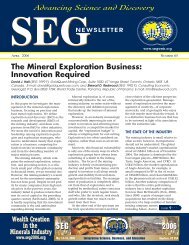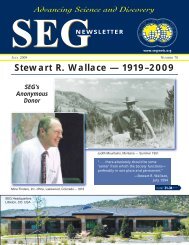10 <strong>SEG</strong> NEWSLETTER No 63 • OCTOBER 2005 ... from 9 Exploring for Deposits Under Deep Cover Using Geochemistry (Continued) the strong anomalies for Zn and Cd were enigmatic. Why would these elements be strongly anomalous over an Au-Cu deposit? Further drilling by Newmont described by Norby and Orobona (2002) revealed the presence <strong>of</strong> a deposit-wide blanket <strong>of</strong> sphalerite concentrated in the upper 60 m <strong>of</strong> the sulfide zone, approximately 500 m below surface. The secondary Zn blanket, containing 1 to 4% Zn, contains submicrometer-sized framboids <strong>of</strong> sphalerite that have extremely low values for δ 34 S, down to –70‰, indicative <strong>of</strong> bacterial reduction <strong>of</strong> sulfate during supergene alteration (Bawden et al., 2003). Cadmium is a ubiquitous constituent <strong>of</strong> sphalerite, with contents typically in the range 0.1 to 0.8% (Piatak et al., 2004). Newmont is currently measuring the Cd content <strong>of</strong> the sphalerite-rich zone. Preliminary results give average Cd/Zn ratios above that obtained from crustal abundance data for these elements. Norby and Orobona (2002) provide additional structural detail for the deposit. The interpreted post-Carlin Formation fault B, where the strongest geochemical anomalies are found at the surface, corresponds to the Nebulous fracture zone, which forms the boundary structure for the West Mike secondary mineralization, including the Zn-rich zone (John Norby, pers. commun., 2003). Its location in the basement was recognized by gravity contrast caused by <strong>of</strong>fsets along the basement unconformity. This fault has a westerly dip (Norby and Orobona, 2002), and thus the surface trace (fault B) shown by the topographic relief is east <strong>of</strong> the gravity expression in the basement (Figure 1a). Similarly, fault C is the surface expression <strong>of</strong> the westerly dipping North-Pointing Dog fault <strong>of</strong> Norby and Orobona (2002). Fault A may be the surface topographic expression <strong>of</strong> a westerly dipping D-Day fault or a down-faulted block between the D-Day and Hillside faults. North-northeast–striking faults, such as the Nebulous, locally control gold mineralization and also down-drop mineralization and the base <strong>of</strong> oxidation. There are landslides along the southwest projections <strong>of</strong> the Nebulous and D-Day faults (John Norby, pers. commun., 2003), which may reflect recent earthquakes. We interpret the anomalies at the surface intersection <strong>of</strong> the Nebulous fracture zone to be the result <strong>of</strong> mobilization <strong>of</strong> metals where the permeable fault zone cuts the ores, and pumping <strong>of</strong> the resulting metalliferous fluids up the fault. It is likely that it was the constituents <strong>of</strong> the sulfide zone that were the most amenable to oxidation and mobilization. In addition to Au, Cu, Cd, and Zn, other elements such as Ag, As, Ba, Hg, Mo, Ni, Sb, Se, and V are anomalous along the surface intersection <strong>of</strong> the Nebulous fault. Major elements such as K and Na, which might indicate hydrothermal alteration, are not enhanced. Isotopic studies by Dublyansky et al. (2003) at the Yucca Mountain nuclear waste disposal site, also in Nevada, have shown that fluids <strong>of</strong> deep-seated origin have moved up several hundred meters along a permeable fault through a thick vadose zone. SPENCE DEPOSIT Spence is a supergene-enriched copper porphyry deposit located between Ant<strong>of</strong>agasta and Calama in the Atacama Desert <strong>of</strong> northern Chile. RioChilex discovered the deposit in 1996 by reconnaissance drilling. Porphyry intrusion and hypogene mineralization took place during the Palaeocene. Following supergene enrichment, the deposit was covered by 50 to 100 m <strong>of</strong> piedmont gravels <strong>of</strong> Miocene age. The gravels are indurated and for the most part are poorly sorted with a fine grained matrix that makes them relatively impermeable, except where fractured or in better sorted layers, as near their base. Copper minerals are atacamite and brochantite within the oxide zone, and chalcocite and covellite in the enriched zone. The primary sulfides comprise chalcopyrite, bornite, molybdenite, tennantite, and pyrite. Reserves recoverable by open-pit mining are 79 Mt <strong>of</strong> oxide ore at 1.18% Cu and 231 Mt <strong>of</strong> sulfide ore at 1.13% Cu. The long axis <strong>of</strong> the deposit and the porphyry intrusions trend north-northeast, similar to the orientation <strong>of</strong> a prominent lineament that runs through the area. We carried out sampling <strong>of</strong> soils and groundwaters within and around the deposit in 1999 and 2000; results are described by Cameron et al. (2004) and Cameron and Leybourne (2005). In this region, groundwater flows southwest. Over most <strong>of</strong> the deposit, the water table lies within the basal gravels, which act as an aquifer, but in the south <strong>of</strong> the deposit it lies below the unconformity. Contents <strong>of</strong> Cl in the groundwaters (Fig. 3) show two distinct types <strong>of</strong> groundwater: low-salinity water east <strong>of</strong> the long axis <strong>of</strong> the deposit, and saline water west and downstream from the axis. There is an order <strong>of</strong> magnitude difference in the Cl content <strong>of</strong> the two waters, which average 1,300 mg/L and 11,600 mg/L, respectively. The maximum for the saline water is 21,200 mg/L, compared to seawater with 19,000 mg/L Cl. The saline water is distinguished by high contents <strong>of</strong> a number <strong>of</strong> elements, most notably As (Fig. 3) and Se, but also, B, Br, Ca, I, K, Li , Mg, Sr, and Rb (Cameron and Leybourne, 2005). The two waters are also distinguished by differences in their isotopic composition. On a δ 2 H vs. δ 18 O plot (Fig. 4), the low-salinity waters plot near the global meteoric water line (GMWL), whereas the saline waters plot well to the right (Cameron and Leybourne, 2005). Formation waters recovered from deep sedimentary basins are different from meteoric waters, both in their higher salinity and the deviation in δ 2 H and δ 18 O values from the GMWL. The saline groundwaters from Spence plot within the field <strong>of</strong> formation waters indicating that the waters found on either side <strong>of</strong> the axis <strong>of</strong> the deposit are <strong>of</strong> different origins: those to the east are meteoric waters, those to the west are formation waters, with mixing <strong>of</strong> the two as they flow down-gradient towards the southwest. The Atacama Desert is hyper-arid; rainfall may occur only once every few years. Recharge for the groundwater that lies beneath the desert floor is in the Andes mountains and foothills ca. 120 km to the east, and precipitation is significant only above altitudes <strong>of</strong> 3,000 m (Spence lies at 1,700 m). The δ 18O composition <strong>of</strong> precipitation varies with the altitude <strong>of</strong> the land surface, becoming increasingly negative with greater altitude. In northern Chile, Aravena et al. (1999) found values <strong>of</strong> δ 18O in the range –5 to –7 ‰ at 2,500 m altitude, decreasing to –20 ‰ above 4,000 m. The least saline <strong>of</strong> the Spence groundwaters, which are interpreted to be <strong>of</strong> meteoric origin, range in δ 18 O from –8 to –11 ‰, consistent with derivation from precipitation at higher altitudes east <strong>of</strong> Spence. Over the deposit, Cu is enriched in both saline and meteoric waters (Fig. 5),
OCTOBER 2005 • No 63 <strong>SEG</strong> NEWSLETTER 11 7482000N 7481000N 7480000N 473000E 474000E 475000E 476000E 473000E 474000E 475000E 476000E 10500 8500 Cl mg/l 15100 21200 6900 900 Groundwater Flow 8600 7100 15000 7000 11200 00 13500 350 6600 660 as a result <strong>of</strong> oxidation <strong>of</strong> the Cu minerals within the deposit, but high values do not persist downflow from the deposit. Copper dissolves in groundwaters as a cation Cu 2+, which is readily adsorbed on negatively charged Fe and Al oxyhydroxide colloids and coatings. 17500 200 1700 3900 2400 24 13600 00 600 60 n/a 100 100 33200 n/a 200 1000 Approximate Limits <strong>of</strong> Mineralization By contrast, higher values for Mo, As, and Se persist in the downflow waters. The latter three elements dissolve as anions, which are not adsorbed by oxyhydroxide colloids. In order to determine which elements are most prone to be adsorbed on oxyhydroxide colloids 50 36 As, ppb 93 73 33 71 29






